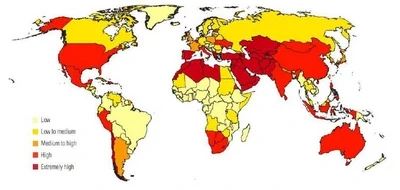Updated: 12 August 2025
Snapshot (2025 → 2045)
Tech is accelerating, but groundwater depletion, glacier loss, permafrost thaw, and rising conflict risk are tightening society’s margins. On present behaviour, expect more regional crises; with targeted action, a resilient “muddle‑through” is still achievable.
Risk map (what breaks first)
| Domain | 2025–2045 risk drivers | Likely impacts | Early warnings |
|---|---|---|---|
| Groundwater (US/global) | Over‑extraction, megadroughts, weak metering/enforcement | Falling water tables, land subsidence, volatile crop yields, food price spikes | Well depth increases, GRACE anomalies, insurance retreat in farm belts |
| Glaciers & snowpack (Alps/Andes/Himalayas) | Continued mass loss, warmer winters | Earlier peak flows, late‑summer water shortages, hydropower constraints, GLOF hazards | Shift in run-off timing, low reservoir levels, glacier mass‑balance declines |
| Permafrost & boreal | Thaw, extreme wildfires | CO₂/CH₄ feedbacks, infrastructure damage, ecosystem change | Active‑layer thickening, fire severity/area burned, net tundra CO₂ source |
| Heat & humidity | Higher wet‑bulb temps, urban heat islands | Labour/learning losses, heat illness spikes, grid strain | Days ≥35 °C, hot nights, hospital admissions |
| Food systems | Synchronized climate shocks, water stress, input price volatility | Export bans, price surges, unrest, aid demand | FAO index jumps, staple yield anomalies, fertilizer/shipping chokepoints |
| Energy & grids | Rapid electrification, slow grid build‑out, extreme weather | Blackouts, curtailment, price volatility | Interconnection queues, reserve margins, storage/hydro shortfalls |
| Finance & insurance | Rising catastrophe losses, disclosure rules bite | Policy withdrawals, higher borrowing costs, muni stress | Reinsurance rate hikes, coverage gaps, downgrades |
| Geopolitics & peace | Arms‑control erosion, resource nationalism | Trade fragmentation, conflict flashpoints, higher defence outlays | Treaty slippage, militarized incidents, sanctions cycles |
| Social cohesion & information | Polarisation, misinformation | Slower emergency response, weaker mandates, unrest | Trust surveys, turnout, verified info reach |
High‑impact levers (2025–2030 window)
Cut emissions while hardening systems
-
Coal‑to‑clean swaps in power; build grids + utility‑scale storage; accelerate heat pumps and efficiency retrofits.
-
Methane abatement (oil/gas leaks, landfill capture, rice/livestock best‑practice)—fastest near‑term cooling.
-
Industrial decarbonisation where feasible (electrify low‑temp heat; green H₂ for niche high‑heat/chemicals).
Water & land resilience
-
Groundwater caps & metering, managed aquifer recharge, crop switching, smart water pricing.
-
Glacier‑lake risk management (monitoring, controlled drainage), floodplain buy‑outs, nature‑based buffers.
-
Urban heat plans: cool roofs/streets, shade, trees, targeted cooling centres.
Peace & security backstops
-
De‑confliction channels; protect grain/energy corridors; scale adaptation finance in fragile regions; revive arms‑control tracks.
Finance & insurance
-
Risk‑based pricing with justice safeguards; resilience bonds; climate‑risk disclosure that drives capex to adaptation.
Society & governance
-
Early‑warning systems, drills, mutual‑aid networks; evidence‑based comms to counter misinformation.
Political overlay (US 2025–2029): implications for the risk map
What changed
-
Paris Agreement exit (2025) and federal climate rollbacks signalled; LNG export permitting restarted; oil & gas development prioritised.
-
Across‑the‑board US import tariffs (baseline 10%) add friction to global trade and raise costs for clean‑tech supply chains (PV, batteries, critical minerals), risking slower deployment.
-
NATO spending shifted up (~5% of GDP target); European defence outlays will rise materially, crowding other budgets unless offset by new revenues.
-
Ukraine diplomacy reset with a US‑Russia summit; talk of territorial concessions raises uncertainty on European security architecture even if a ceasefire emerges.
Net effect on 2045 outlook
-
Emissions track: higher than prior baseline (more LNG/oil, weaker US rules) → marginally higher 2030–2040 warming and adaptation costs.
-
Markets: tariffs + policy whiplash → higher capex costs, slower clean‑tech diffusion in the near term; long‑run tech learning still strong.
-
Peace/security: Near‑term deterrence may improve via higher NATO spend, but strategic risk rises if any Ukraine deal undermines norms on territorial integrity.
Revised scenario odds (subjective)
-
Muddle‑through: 40%
-
Fragmented downturn: 40%
-
Cooperative pivot: 20%
Near‑term moves for Switzerland/Europe (practical)
-
Heat pumps + district energy at speed; expand pumped‑storage and flexible Alpine hydropower; streamline cross‑border grid links.
-
Water: Rhine/Aare basin drought compacts; control glacier‑lake outburst risks; fix municipal leakage; incentivise drought‑tolerant landscaping.
-
Agriculture: support drip irrigation, soil‑moisture retention, and crop shifts where water is tight.
-
Community resilience: summer cooling hubs, backup power for clinics, neighbourhood check‑ins during heatwaves/floods.
A positive note: individual responsibility & consciousness
Even on a rough trajectory, there is a kind of resilience that starts inside. In the spirit of Prem Rawat’s emphasis on awareness and personal responsibility:
-
Attention first: a few quiet minutes daily (breath, presence) sharpen judgment and soften reactivity—useful in heatwaves, outages, and tense civic moments.
-
Conduct that reduces harm now: prefer comfort and sufficiency over excess; choices that feel good immediately (sleep‑cooling, mindful food, repairing) also lower water/energy strain.
-
Connection that holds under stress: know a few neighbours by name; exchange numbers. Communities with trust ride out shocks better than those with more gadgets but weaker ties.
These are not grand fixes. They simply reduce the fray where we stand and keep our humanity intact while larger systems catch up.
Leading indicators to watch (simple dashboard)
-
Groundwater levels (Ogallala, Central Valley) & GRACE trends
-
Swiss glacier mass‑balance (%/yr) & hydropower summer capacity factor
-
Days with WBGT > 28 °C in major cities; heat‑related ER admissions
-
FAO Food Price Index (3‑month avg) & key export restrictions
-
Reinsurance renewals (Jan/Apr) rate changes and coverage gaps
-
Arms‑control/warhead inventories (SIPRI) & de‑confliction activity
-
Global methane growth rate (ppb/yr)
Bottom line: Without sharper policy, expect a rougher “muddle‑through.” With targeted cuts (esp. methane), strong water governance, and peace backstops, 2045 can be difficult and liveable.


Comments powered by CComment